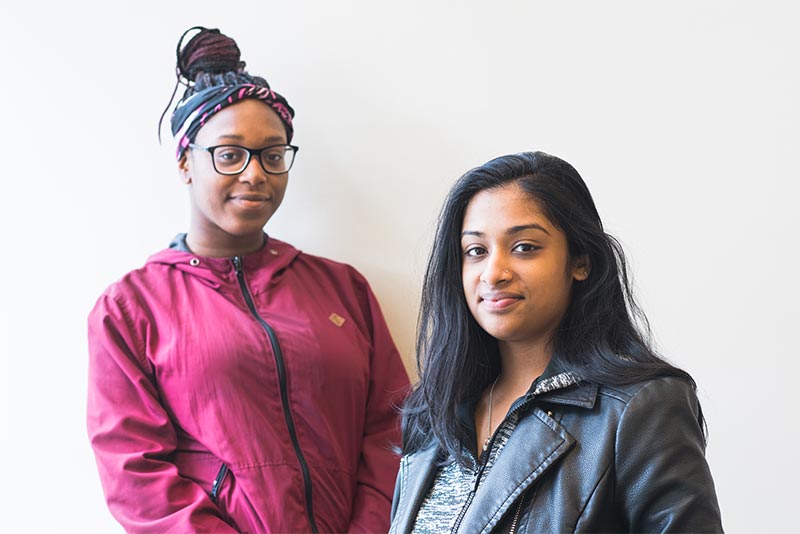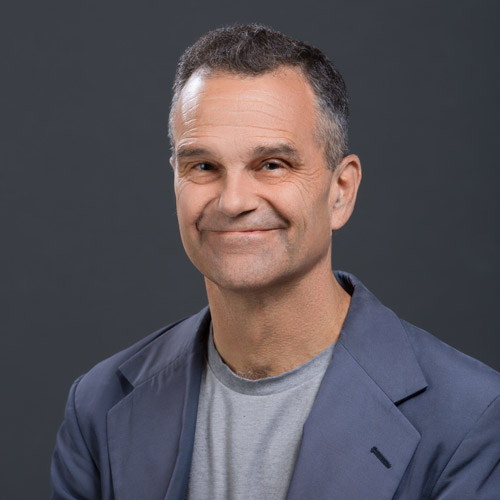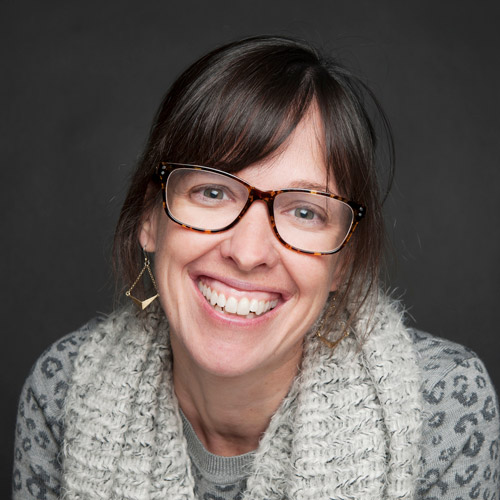Urban Youth of Color Stressed by Violence, Official Indifference
BU-led survey used young people to interview their peers

Melissa Maharaj (right) and Chaurice McMillan have experienced lack of healthy food stores and other problems in parts of Boston.
As researchers, Melissa Maharaj and Chaurice McMillan have lived the subject they study, which is stress in the lives of urban youth of color.
McMillan, a Lesley University student from Boston’s Mattapan section who attended high school in affluent Brookline, knows you’re likelier to see a yeti in her neighborhood than an affordable, healthy food store. “There are no fast food restaurants near my school,” she says. “There’s only, like, Whole Foods and Trader Joe’s and vegan food. And then I go home and there’s McDonald’s and Burger King on every corner.”
Maharaj, a Northeastern grad who lives in the city’s Dorchester area, recounts how during a trip through Brookline recently, a bus driver thought an African American friend of hers was playing music too loud (he had earbuds, she says) and summoned police. “If that was in my neighborhood in Dorchester, the police would not come.”
So when America’s Promise Alliance’s national research institute, the Center for Promise, which is housed at the Boston University School of Education, conducted a five-city survey of youths of color, by youths of color, Maharaj and McMillan, who is studying to be a teacher, joined the Boston team. The former had once worked for the Center for Promise, and she recruited McMillan and other young people to be surveyors.
Their key finding after interviewing about 120 Bostonians ages 16 to 25, mostly black and Hispanic: “Over 80 percent identified as being stressed,” says Maharaj, especially by neighborhood violence and distrust that police would do anything about it.
The project, the most expansive youth-led study that the BU researchers know of, also involved Philadelphia, Chicago, Denver, and St. Paul. Troubled police relations “was the only issue that emerged in all five cities,” where more than 400 young people in total were surveyed, says project lead investigator Linda Sprague Martinez, a BU School of Social Work assistant professor of macro practice and a Center for Promise research fellow. That different issues emerged across the cities happened partly because the center gave each city’s youthful surveyors wide leeway in choosing the questions to ask.

“As adults, we have these preconceived notions of what young people need, which isn’t always the case. You know, it’s been a long time since I was 13,” Sprague Martinez says.
She and two Center for Promise staffers trained the young people about research techniques and influences on health for the survey. But crisscrossing the country (“Just on Jet Blue—which does not fly to St. Paul—I have 60,000 miles,” she says), she kept in mind that the interviewers were to determine what questions to ask. “We recognize that young people are experts in their own lived experience, and that if we really want to develop programs that meet their needs…they need to be leading the process.”
The study, conducted from May to October 2016, was paid for by Target, a retailer that has a wellness initiative, Sprague Martinez says. Overall, the survey revealed “that youth are facing incredible barriers to their health and well-being that have little to do with…their own individual behavior, and have much more to do with broader-level societal factors,” like race and poverty.
“We designed the project for youth of color,” she says, “because there are such grave inequities in health and well-being, and young people of color are just disproportionately impacted by a number of conditions in terms of dropout rate, in terms of their own health outcomes.”
The inter-city differences could be striking. Substance abuse was not a big concern in Boston despite the opioid epidemic, she says. “But they did talk a lot about mental health”—depression, anxiety—“which none of the other cities talked about.” Boston respondents also corroborated the healthy food desert McMillan describes.
Sprague Martinez acknowledges that allowing each city’s team to customize questions limits the ability to generalize results. Another limitation: the 400-plus respondents, total, among the five cities are a small sample. Still, the fact that violence and troubled relations with police plague all five cities (and that the finding didn’t surprise young residents like Maharaj and McMillan) suggests the problems are not make-believe, as Sprague Martinez, who lives in Roxbury, can attest.
While her immediate neighborhood is a higher income one, “I wouldn’t let my kids outside alone,” she says, in an area where she recalls two instances of gunshots in the last 14 years.
The study makes broad recommendations, many involving private and personal initiative. It calls on city officials and youth-serving community organizations to invest in public safety, juvenile justice, and training to help young people traumatized by violence and police brutality. Law enforcement should police negative behavior by officers toward young people, while seeking chances for positive interactions. And public health authorities and donors should consider “holistic” investments in their cities that are informed by young people’s input.
For all the problems they cited, Boston’s youths stood out for their confidence in their power to make change. “An overwhelming percentage said that,” Maharaj notes. “When you come from a place where there’s not much help or access or resource assistance…you kind of have to think or be hopeful. Otherwise, what do you have?”


Comments & Discussion
Boston University moderates comments to facilitate an informed, substantive, civil conversation. Abusive, profane, self-promotional, misleading, incoherent or off-topic comments will be rejected. Moderators are staffed during regular business hours (EST) and can only accept comments written in English. Statistics or facts must include a citation or a link to the citation.